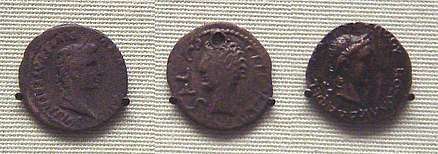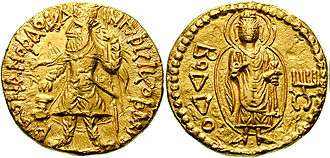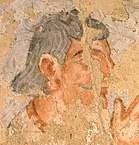Kujula Kadphises
Kujula Kadphises (Kushan language: Κοζουλου Καδφιζου, also Κοζολα Καδαφες; Kharoṣṭhī: Kujula Kasasa; Ancient Chinese: 丘就卻, Qiujiuque; reigned 30–80 CE, or 40-90 CE according to Bopearachchi[1]) was a Kushan prince who united the Yuezhi confederation during the 1st century CE, and became the first Kushan emperor. According to the Rabatak inscription, he was the great grandfather of the great Kushan king Kanishka I. He is considered the founder of the Kushan Empire.[1]
| Kujula Kadphises | |||||
|---|---|---|---|---|---|
| Kushan emperor | |||||
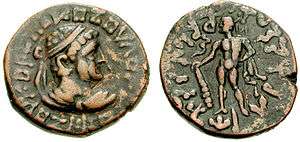 Tetradrachm of Kujula Kadphises (30-80 CE) in the style of Hermaeus. | |||||
| Reign | January 27, 30 CE - November 7, 80 CE | ||||
| Predecessor | Heraios | ||||
| Successor | Cagaragus | ||||
| Born | 4 BCE Herat, Afghanistan | ||||
| Died | November 7, 80 CE Multan, Pakistan | ||||
| Burial | |||||
| Spouse | Arphratres | ||||
| Issue | Cagaragus | ||||
| |||||
| House | Kujulids | ||||
| Dynasty | Kushan | ||||
| Father | Phraates IV | ||||
| Mother | Musa | ||||
History
The origins of Kujula Kadphises are quite obscure, and he is usually believed to be a descendant of the Kushan ruler Heraios, or possibly identical with him.[2] However, Kujula shares his name (Kushan: Κοζουλου on some of his "Hermaeus" coins, or Κοζολα on his "Augustus" coins) with some of the last Indo-Scythian rulers, such as Liaka Kusulaka (Greek: Λιακα Κοζουλο), or his son Patika Kusulaka, which might suggest some family connection.[3]
Chinese accounts

Obv Laureate Julio-Claudian style head right. Greek legend Greek legend around: ΚΟΖΟΛΑ ΚΑΔΑΦΕϹ XOPANOV ZAOOV.
Rev Kujula Kadphises seated right, raising hand; tripartite symbol to left. Legend Khushanasa Yauasa Kuyula Kaphasa Sacha Dhramatidasa.
There are few contemporaneous accounts of Kujula Kadphises; since none of these texts are by Kushan authors, their accuracy and the motives of the authors may be questionable. For example, the rise of Kujula Kadphises is portrayed, in a later Chinese historical chronicle, Hou Hanshu, as the result of a bloody civil war.
[T]he prince [xihou] of Guishuang, named Qiujiuque [Kujula Kadphises], attacked and exterminated the four other princes [of the Yuezhi]. He established himself as king, and his dynasty was called that of the Guishuang [Kushan] King. He invaded Anxi [Indo-Parthia], and took the Gaofu [Kabul] region. He also defeated the whole of the kingdoms of Puda [Paktiya] and Jibin [Kapisha and Gandhara]. Qiujiuque was more than 80 years old when he died.[4]
In the process of their expansion eastward, Kujula Kadphises and his son Vima Takto (or Vema Tahktu) seem to have displaced the Indo-Parthian kingdom, established in northwestern India by the Parthian Gondophares since around 20 CE:
His son, Yangaozhen [probably Vema Tahktu or, possibly, his brother Sadaṣkaṇa], became king in his place. He defeated Tianzhu [North-western India] and installed Generals to supervise and lead it. The Yuezhi then became extremely rich. All the kingdoms call [their king] the Guishuang [Kushan] king, but the Han call them by their original name, Da Yuezhi [Great Yuezhi].[4]
The invasion of the Indo-Parthian kingdom led by Kujula Kadphises is thought to have occurred some time after 45 CE, during the reign of Gondophares's successors: Abdagases and Sases.
Genealogy according to the Rabatak inscription

The connection of Kujula with other Kushan rulers is described in the Rabatak inscription, discovered in Rbatak, Afghanistan some years ago, which was written by Kanishka. Kanishka makes the list of the kings who ruled up to his time: Kujula Kadphises as his great-grandfather, Vima Taktu as his grandfather, Vima Kadphises as his father, and himself Kanishka:
And he [Kanishka] gave orders to make images of the same, (namely) of these gods who are written herein, and he gave orders to make (them) for these kings: for King Kujula Kadphises (his) great grandfather, and for King Vima Taktu (his) grandfather, and for King Vima Kadphises (his) father, and for himself, King Kanishka.[5]
Coinage
Most of Kujula's coins were Hellenic or Roman in inspiration. Some coins used the portrait, name and title of the Indo-Greek king Hermaeus on the obverse, indicating Kujula's wish to relate himself to the Indo-Greek king. Since the Kushans and their predecessors the Yuezhi were conversant with the Greek language and Greek coinage, the adoption of Hermaeus cannot have been accidental: it either expressed a filiation of Kujula Kadphises to Hermaeus by alliance (possibly through Sapadbizes or Heraios), or simply a wish to show himself as heir to the Indo-Greek tradition and prestige, possibly to accommodate Greek populations. These coins bear the name of Kujula Kadphises in Kharoṣṭhī, with representations of the Greek demi-god Heracles on the back, and titles ("Yavugasa") presenting Kujula as a "ruler" (not actual king), and a probable Buddhist ("Dharmathidasa", follower of the Dharma). Later coins, possibly posthumous, did describe Kujula as "Maharajasa", or "Great King".
Greek script
The Greek script on the coins of Kujula (and all the Kushans with him) is barbarized. For example, ΣΤΗΡΟΣΣΥ on his Hermaeus coins is thought to be a deformation of ΣΩΤΗΡΟΣ (Sotiros), the traditional title of Hermaeus on his coins. The Greek word for "king" is written ΒΑϹΙΛΕΩΣ, with both a lunate sigma (Ϲ) and a normal sigma (Σ) in the same word.
The Kushans also added one character to the Greek script: it is the letter Ϸ, corresponding to the sound "Sh", as in "Kushan".
"Buddha" coins

Obv Kujula seated cross legged facing, Kharoshti legend: Kuyula Kadaphasa Kushanasa.
Rev Zeus on the reverse, Greek legend: ΚΟΖΟΛΑ XOPANOY ZAOOY.
Some coins of Kujula also represent a cross-legged seated figure, formerly said to be one of the first known representations of the Buddha on a coin (Whitehead). Unfortunately, Whitehead's attribution of this coin to Kujula, and the claim that the seated figure on the obverse represents the Buddha, is now known to be incorrect. The correct attribution of this coin is to the Kushan king Huvishka, who was Kujula's great-great-grandson. The obverse shows Huvishka seated on a couch. The first known coins carrying a representation of the Buddha were issued by Kujula's Great-grandson (and Huvishka's father) Kanishka I.
Roman-style coins
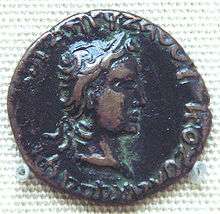
Some fewer coins of Kujula Kadphises also adopted a Roman style, with effigies closely resembling Caesar Augustus, although all the legends were then associated with Kujula himself. Such influences are linked to exchanges with the Roman Empire around that date.
References
| Kushan Empire 30 CE–350 CE | ||||||||||||||||||||||||||||||
|---|---|---|---|---|---|---|---|---|---|---|---|---|---|---|---|---|---|---|---|---|---|---|---|---|---|---|---|---|---|---|
|
||||||||||||||||||||||||||||||
- Osmund Bopearachchi, 2007, Some observations on the chronology of the early Kushans
- Cribb, J. (1993), The Heraus coins: their attribution to the Kushan king Kujula Kadphises, c. AD 30-80. Essays in Honour of Robert Carson and Kenneth Jenkins, (edited by M. Price, A. Burnett, and R. Bland), London, 107-134.
- Rapson, "Indian coins of the British Museum", p.cvi
- Hill (2009), p. 29.
- Sims-Williams' "provisional translation" quoted in Hill (2009), p. 592.
Bibliography
- "Catalogue of coins in the Panjab Museum, Lahore. Vol. I Indo-Greek coins", Whitehead, Argonaut Inc. Publishers, Chicago.
- Chavannes, Édouard (1907). Les pays d'occident d'après le Heou Han chou. T’oung pao 8. pp. 149-244.
- Hill, John E. 2004. The Western Regions according to the Hou Hanshu. Draft annotated English translation.
- Hill, John E. (2009). Through the Jade Gate to Rome: A Study of the Silk Routes during the Later Han Dynasty, First to Second Centuries CE. BookSurge. ISBN 978-1-4392-2134-1.
External links
| Preceded by Heraios (Gandhara, Punjab) |
Kushan Ruler 30 – 80 CE |
Succeeded by Heraios (as Kushan King) |
| Preceded by Vima Takto (as Indo-Parthian king) |
- From the dated inscription on the Rukhana reliquary
- An Inscribed Silver Buddhist Reliquary of the Time of King Kharaosta and Prince Indravarman, Richard Salomon, Journal of the American Oriental Society, Vol. 116, No. 3 (Jul. - Sep., 1996), pp. 442
- A Kharosthī Reliquary Inscription of the Time of the Apraca Prince Visnuvarma, by Richard Salomon, South Asian Studies 11 1995, Pages 27-32, Published online: 09 Aug 2010
- Cribb, Joe; Donovan, Peter (2014). Kushan, Kushano-Sasanian, and Kidarite Coins A Catalogue of Coins From the American Numismatic Society by David Jongeward and Joe Cribb with Peter Donovan. p. 4.
